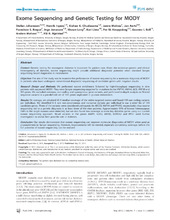| dc.description.abstract | Context: Genetic testing for monogenic diabetes is important for patient care. Given the extensive genetic and clinical heterogeneity of diabetes, exome sequencing might provide additional diagnostic potential when standard Sanger sequencing-based diagnostics is inconclusive. Objective: The aim of the study was to examine the performance of exome sequencing for a molecular diagnosis of MODY in patients who have undergone conventional diagnostic sequencing of candidate genes with negative results. Research Design and Methods: We performed exome enrichment followed by high-throughput sequencing in nine patients with suspected MODY. They were Sanger sequencing-negative for mutations in the HNF1A, HNF4A, GCK, HNF1B and INS genes. We excluded common, non-coding and synonymous gene variants, and performed in-depth analysis on filtered sequence variants in a pre-defined set of 111 genes implicated in glucose metabolism. Results: On average, we obtained 45 X median coverage of the entire targeted exome and found 199 rare coding variants per individual. We identified 0–4 rare non-synonymous and nonsense variants per individual in our a priori list of 111 candidate genes. Three of the variants were considered pathogenic (in ABCC8, HNF4A and PPARG, respectively), thus exome sequencing led to a genetic diagnosis in at least three of the nine patients. Approximately 91% of known heterozygous SNPs in the target exomes were detected, but we also found low coverage in some key diabetes genes using our current exome sequencing approach. Novel variants in the genes ARAP1, GLIS3, MADD, NOTCH2 and WFS1 need further investigation to reveal their possible role in diabetes. Conclusion: Our results demonstrate that exome sequencing can improve molecular diagnostics of MODY when used as a complement to Sanger sequencing. However, improvements will be needed, especially concerning coverage, before the full potential of exome sequencing can be realized. | en_US |

